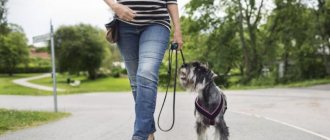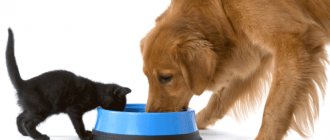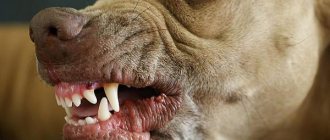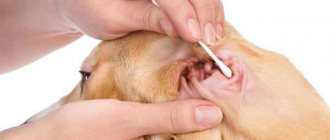The main mistakes of dog breeders
Let's look at some mistakes that dog breeders can make when raising a tail.
Encouraging Fear
Trying to calm the animal, the owner begins to feel sorry for the four-legged animal, help it hide from frightening stimuli, pick it up, stroke it and talk to it affectionately. Under no circumstances should this be done.
Such signals only help convince the animal that something terrible is happening. The dog believes that it is behaving correctly by trying to hide. The dog is afraid. This only intensifies the panic.
The owner begins to scold the pet
If a dog is afraid of something, you cannot scold, much less beat, the four-legged dog. This will keep the little dog from being afraid of extraneous sounds. He will not understand at all why he is being scolded. But on top of that, he may also begin to fear his owner.
The dog is afraid of the street
This is a very common fear. The dog is afraid of various loud sounds from passing trucks, tractors, buses and trams.
The animal experiences enormous stress from the roar and rumble of these monstrous “monsters” and from their terrifying, menacing appearance. It tries to break free and run away “at breakneck speed.” And this can lead not only to the fact that, having run a huge distance out of fear, your pet will get lost and will not be able to return home, but also, if it gets under the wheels of a car, it may die.
To prevent this from happening, you need to accustom your dog to the street from a very early age.
Take your pet for a walk on noisy, busy streets. Start these walks with a few minutes, gradually increasing the time of walking every day. This is the only way your furry friend will sooner or later get used to it and stop experiencing stress.
When a dog is afraid of transport, you need to act in exactly the same way. Take the tailed one on a tram or bus. Drive one or two stops without reacting in any way to the four-legged fears.
Pity is of no help to you in such matters. Only patience, time and daily training will bring positive results.
This is exactly the fear we faced when our Jackusik was very small and we just started taking him outside. I tried to walk with him as often as possible, closer to the roadway. He shied away from everything. From a passing tractor, the rumble of a tram and just a sudden sharp sound. He started to panic and pulled me into the yard, where there was no this terrible noise. But I did not follow his lead and stubbornly continued to go out every day to the street that frightened him. And, I must say, he very quickly got used to it and stopped paying attention to such irritants.
Signs of fear in dogs
Understanding your dog's body language will help you train a healthy four-legged dog when he is relaxed, nervous or intimidated. Look for the following signs that indicate fear :
- the dog is watching another dog, but slightly bows its head,
- squeezes the tail and hides it between the hind legs,
- pulls back the body, drawing an arc with the spine,
- it appears as if your dog is paralyzed,
- puts ears to head
- growls or tries to run away,
- involuntary urination.
The dog is afraid of firecrackers and fireworks
If your dog is afraid of firecrackers and fireworks, it is important that the owner remains calm and balanced. In your pet's eyes, you are the leader of the pack. And it is very important that, looking at you, the dog understands: the leader is not afraid, which means I have nothing to fear.
If fireworks find you at home
If fireworks catch you at home, remain calm and sit the dog next to you, at your feet. Do not calm the animal. Command: “Near!”, “Sit!” and, holding the pet, remain in this position until the end of the volleys.
Don't let the tail change position or go anywhere. It’s better to let your pet concentrate on following the command than on his fear of the roar of gunfire.
At the end of the shots, praise the dog and give it a treat. Another way to prevent an animal from panicking is to distract it from the volleys by playing together.
Turn on the music, start dancing, jumping, take your pet's favorite toy and involve him in the game. Ignore panicky behavior and do not try to calm the animal. Our Jack, for example, really loves these rubber squeaky toys.
As a rule, we most often encounter volleys of fireworks on New Year's Eve. Read more about how to help and protect your pet at this time.
If fireworks caught you on the street
If the fireworks show catches you on the street, make a short leash and command: “Nearby!” Ignoring the four-legged's fears, continue moving.
No matter how your four-legged friend learns to calmly react to shots, do not forget about the safety measures:
- Try to walk your pet before dark, when the likelihood of fireworks being set off is especially high.
- Make sure your ammunition is strong enough.
- Be sure to make an address book indicating your phone number and the dog’s name in case it suddenly gets scared and runs away.
How to train a dog to shoot shots
If your dog is afraid of firecrackers and fireworks, you need to try to accustom him to these sounds. Try this:
- Buy some firecrackers.
- First, take your ponytail for a walk, try to be active in order to take as much energy from your four-legged dog as possible.
- Go with your pet to a sparsely populated place where no one will bother you.
- Put a collar on your dog, take him on a short leash and sit him down.
- Light the firecracker and throw it at a safe distance.
- If the dog changes position or gets up, immediately put it back in place.
- Throw 3-4 firecrackers in one session, taking a break of about a minute between throws.
- Repeat this exercise every day until your pet responds calmly to these sounds.
Phobias in dogs. How to help your dog get rid of phobias?
Let's look at what phobias dogs are susceptible to, how they arise, and how to help our four-legged friend in such a situation.
- Fear of loud sounds (fireworks, thunder, gunshots). When we bring a tiny puppy into the house, at first he is afraid of everything, including loud sounds. This is fine. As the puppy gets used to the owner and the new environment, fears go away. If this does not happen, then the dog has congenital mental problems. It also happens that adult dogs begin to be afraid of loud noises. Most often this happens if a firecracker or firecracker explodes not far from the dog. Or the dog experienced stress and associated it with loud sounds. If the dog is afraid of loud sounds, the dog must be gradually accustomed to them: to the sound of keys falling or, for example, a lid from dishes in the kitchen, to the sound of a bursting ball. At first, a loud sound should not be a surprise to the dog; it must see what is happening, otherwise its fear will intensify.
- Fear of vehicles and traveling in them. The owner is most often to blame for the appearance of this phobia. If a dog has been seeing cars, buses, trolleybuses at a distance for a long time, has never approached them and has never been taken anywhere, then hysteria is a normal reaction when you try to put your pet in the brand new car you bought. This type of phobia can develop if the animal is hit by a car, which can also be blamed on an inattentive owner. The dog must be trained to travel in public transport from puppyhood. First, you need to give the dog the opportunity to get acquainted with the iron “monster” and sniff it from all sides. Then you can take your dog for a walk, so that the trip is associated with something pleasant. You need to train your dog not only to travel in your own car, but also on public transport. This will solve many problems if you need to go somewhere.
- Fear of water. Most people believe that all dogs are naturally excellent swimmers. Actually this is not true. Therefore, if you forcibly drag your pet into the water or, even worse, throw it out in the middle of a river or lake, this can cause panic in the dog and even lead to psychosis and the development of a phobia.
You can rid your dog of his fear of a large body of water by showing him that you are swimming calmly in it, that there is no danger or threat in it. First, let the dog stand on the shore and just look at you. If she is calm, you can bring her closer to the water and wet her paws. At the next stage, you can take a treat or your dog’s favorite toy and move a little away from the shore. Then the dog will have to take several steps in the water to get them. Next time you need to move a little further from the shore and increase the distance until the dog understands that there is nothing scary in the water and starts swimming. If you yourself do not swim, then you can recruit another dog as an assistant who is not afraid of water and swims with pleasure. Looking at it, your pet will want to get to know the water better.
In order for a dog to stop experiencing uncontrollable fear of something, it needs human help. Without a loving, attentive and patient owner, a dog will not be able to overcome its fears on its own. Phobias in dogs can be corrected, but remember that this is not a quick process and will require persistence and patience on your part.
The dog is afraid of other dogs
If your dog is afraid of other dogs, this indicates that your pet is unsocialized. This means that as a puppy, your pet had little contact with its own kind.
The more an animal communicates with its relatives, the more experience of such communication and behavior in a pack appears. Find four-legged friends. It is important that these are different dogs, so that the puppy does not get used to communicating only with one particular animal.
Choose non-aggressive four-legged animals so that your pet does not become even more withdrawn and afraid. Take toys for a walk, leave the ball, and let the dogs have fun running after it. This way the dog will understand that when he meets a strange dog, he can have fun playing and will no longer be afraid of other dogs.
Don't react to signs of cowardice. Praise for courage, and strictly command for aggression: “Ugh!” By the way, you can teach your dog basic commands yourself.
The dog is afraid of people
What to do if your dog is afraid of people? Fearing a person, an animal can react in the following ways.
Showing fear, hiding in a corner
If, showing fear, your pet hides in a corner, do not try to force it out of there, and especially, do not yell at it under any circumstances. This will only make the situation worse.
This is where persuasion and affection will help. Calm the dog down, show him that you are with him and support him.
Ask someone you know to come visit you. Let your friend talk to the dog and give it a treat. This is the only way the dog will understand that it is not in danger.
Shows aggression
There are different types of aggression in dogs. Each type of aggression must be considered individually in order to identify exactly the aggression that is inherent in your pet. Read about aggression in dogs.
Experiencing fear of a person, a dog often also begins to show aggression. Moreover, it very rarely happens that an animal is afraid of absolutely all people.
Usually the four-legged animal cannot stand the company of any one category of people. These could be men, drunk people, people with external signs unusual for a dog (for example, a man on crutches or a grandmother with a stick). And there are reasons for this. Probably, at some point in the animal’s life, the person whom the dog is afraid of offended or frightened the four-legged animal.
The adaptation process can take a long time. In any case, you must not forget: in order to wean a dog from being afraid of people, you need to surround it with love and care. And under no circumstances should you scold the tailed one.
To summarize, I would like to note a few basic rules for overcoming a dog’s fears.
Causes of fear
In all dogs, the process of socialization must begin at an early age, when your dog is still a small puppy, this requires training to interact with other pets and people outside the home. Even those dogs that have had various contacts can show fear of members of their own species. The main reasons for this are :
- Injury,
- premature weaning,
- insufficient socialization,
- overindulgence.
Basic Rules
Try following these rules of conduct:
- Never punish a dog if it is afraid of something.
- If the dog is afraid of street noise or gunshots, do not give in to the four-legged panic behavior, do not feel sorry for him or try to calm him down. All these signals only help convince the animal that something terrible is happening, and it behaves correctly, trying to hide. This only intensifies the panic.
- Show indifference to firecrackers, distract your dog by playing together or focus on following the command.
- If during a panic the animal is not prone to diarrhea, feed the tail. A full stomach has a calming effect.
- If shots catch you on the street, remain calm and do not let your dog off a short leash and follow the given direction.
- Take safety precautions. Check the durability of the ammunition and the presence of an address card.
If your dog is afraid of something, only daily exercise, patience and love for your four-legged friend will bring positive results.
Take care of your pets!











